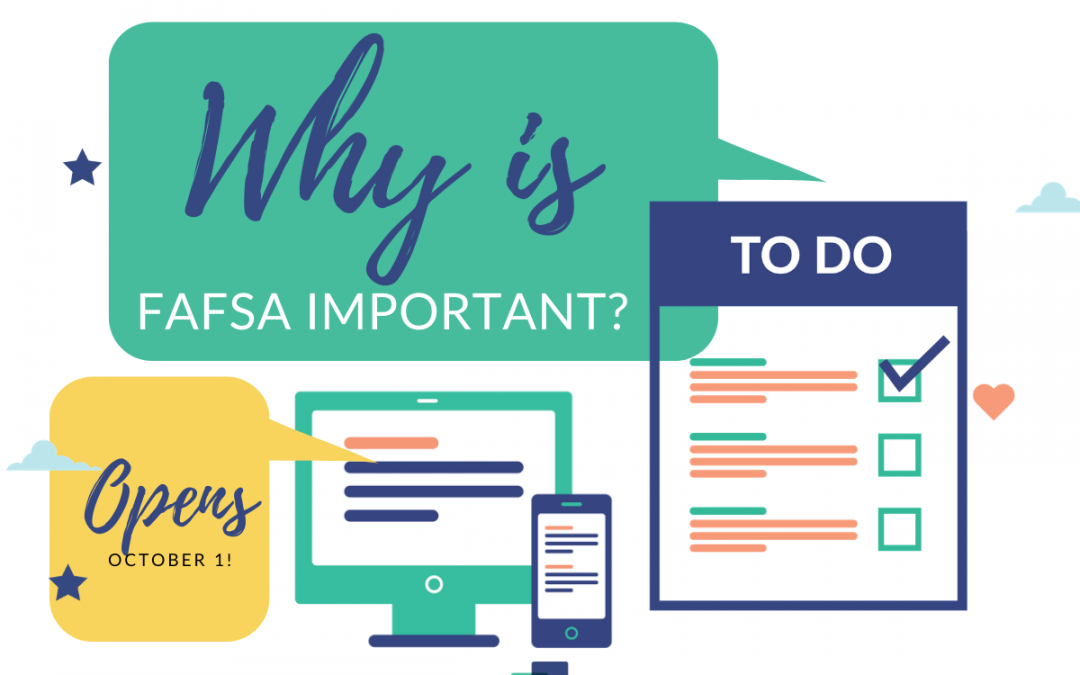This post may contain affiliate links.
Oooh, friends, the FAFSA opens October 1. The Free Application for Federal Student Aid (FAFSA), used to calculate something called the expected family contribution (EFC), measures a family’s financial strength and eligibility for financial aid.
Once, Mr. Donelson, my student Chris’ dad, swaggered into my office and said, “We don’t file the FAFSA. I make too much money.”
Not one to meekly say, “Okay, it’s your choice,” I took a wild gamble, knowing full well my boss would have a coronary. I said, “Sir, how close are you to retirement?” (It was a gamble because I wasn’t sure if he was actually close to retirement or not.)
“A year, tops.” (Whew.)
“How many kids do you have in college right now?” (I already knew that answer.)
“After Chris, we’ll have four in college all at the same time,” he said proudly.
“Did you know the FAFSA takes those factors, like time to retirement and kids in college, into consideration?” I asked politely.
“Hmmm,” he responded.
He filed the FAFSA and I’m happy to tell you that his son received federal aid, including work-study. He worked in our admission office as a tour guide and was a total rock star.
Why is the FAFSA important? I’m so glad you asked.
Contents
- 1. You’ll find hidden secrets.
- 2. Your child can qualify for federal aid.
- 3. You might have to do it for your child to qualify for other aid.
- 4. Your child can get work-study.
- 5. You might have to do it anyway.
- 6. Most students qualify for federal loans.
- 7. You don’t have to accept all aid.
- 8. Your child may leave money on the table.
- 9. Situations change.
- 10. It’s free.
- 11. It’s easy.
- 12. You can gather just a few materials to fill it out.
- 13. It (could) ensure your child goes to college.
- 14. You can fill it out early — then relax.
- 15. It helps schools that also require the CSS profile to understand your full financial picture.
- You Want the Best Shot Possible
Actually, these secrets — not so hidden. But you won’t know unless you file. Everyone should file the FAFSA! Even if you can fill an Olympic-sized pool with all of your $100 bills, you should file the FAFSA. As I shared with Mr. Donelson, there’s more that goes into the expected family contribution, or EFC, than just parent income.
Your family’s taxed and untaxed income, assets and benefits (such as unemployment or Social Security) chips into the formula. Also rolled into it: Family size and the number of family members who will attend college or career school during the year.
2. Your child can qualify for federal aid.
Your child will not get federal aid if you don’t file the FAFSA. Completing this form is the only way to receive state and federal financial aid.
The U.S. Department of Education uses the FAFSA to determine your eligibility for federal student aid. This includes low-cost loans, grants
Put federal student aid to the side for a sec. The FAFSA may also determine your student’s eligibility for other forms of financial aid through the state, the college
By the way, I wholeheartedly recommend checking out the Scholarship System’s free webinar. It is excellent at helping you navigate scholarships!
4. Your child can get work-study.
I mentioned this already but I think it deserves a second mention. Federal work-study is a way you can earn money while your child works a part-time on-campus job. (You may be able to get off-campus jobs as well.) Not every school participates in the Federal Work-Study Program, so ask whether colleges your child wants to attend participate.
Colleges offer a specific amount of funds to each eligible student. Students receive money based on the hours they work, very similar to other hourly jobs.
5. You might have to do it anyway.
Depending on where your child goes to school, completing the FAFSA is a prerequisite for high school graduation. Check with your student’s guidance counselor for more information.
6. Most students qualify for federal loans.
Never, ever, ever, ever EVER take out private student loans before federal loans. Private loans have high interest rates and lack the consumer protections that federal student loans include.
The Institute for College Access and Success reports that 47 percent of private loan borrowers could have used more affordable federal loans. By completing the FAFSA form, you can make sure your student takes advantage of the best student loan options.
7. You don’t have to accept all aid.
Completing the FAFSA does not obligate your child to accept student loans or any other form of financial aid. So, for example, let’s say your child gets:
- Scholarships
- Federal student loans
- State grants
- Federal work-study
You and your child can decide you want the scholarships and grants (free money) but don’t want the federal student loans (must be repaid).
Many families think they have to take everything the student gets awarded — but that’s just not true!
8. Your child may leave money on the table.Take a wild guess at the percentage of high school graduates who completed the FAFSA in 2014.
Only 44 percent.
All that money — unused! It means billions of dollars left on the table.
9. Situations change.
What happens if you experience a change in income? You’ll be glad you filed.
Situations change. Unfortunately, jobs get lost, people pass away, etc. Your financial situations can change. Remember, you can always appeal for more aid every year.
Just because your student doesn’t receive financial aid one year doesn’t mean that he or she can’t get it another year.
10. It’s free.
Note the “Free” in “Free Application for Federal Student Aid.” It costs exactly no money to apply, and more importantly, you don’t have to pay anything to find out whether your child is eligible for federal aid.
11. It’s easy.
It’s no longer the behemoth it once was. (I remember my dad spending hours hunched over the paper version when I was in college.) Now, it takes just 55 minutes to fill it out. That’s less than the time it takes to order and eat a pizza. That’s less than an entire Netflix episode.
12. You can gather just a few materials to fill it out.
What materials should I gather in advance before starting the FAFSA?
- Your Federal Student Aid (FSA) account.
- Social Security Number for both parents and students.
- Both parents and students need this information for the FAFSA form.
- Driver’s license number (if you have one).
- Your 2019 tax records for the 2021–22 FAFSA form. You report your 2019 income information on this year’s form.
- Records of untaxed income, such as child support, interest income, and veterans’ non-education benefits.
- Your assets (money) from savings and checking account balances, investments and real estate, though you don’t include your primary residence.
- List of the school(s) on your child’s list. Add any college your child’s considering, even if you haven’t applied or been accepted yet. You can list up to 10 schools at a time on the FAFSA.
13. It (could) ensure your child goes to college.
Ninety percent of high school seniors who complete the FAFSA proceed directly to college, versus only 55 percent who don’t complete the FAFSA, according to the National College Access Network (NCAN).
14. You can fill it out early — then relax.
Fill it out as soon as possible! Even if you don’t know which school you plan to attend. You can always add various schools’ FAFSA code to your already-filled out FAFSA as the year progresses. So, let’s say you file the FAFSA on October 1. You add three schools that you want the FAFSA to be sent to, then you become interested in another school in November. You can log back in and have it sent to that school as well.
It’s also okay to add a school to the FAFSA that you decide later on that you won’t apply for.
15. It helps schools that also require the CSS profile to understand your full financial picture.
What’s the diff between the FAFSA and CSS Profile? The FAFSA awards families with federal grants, scholarships and student loans, while the CSS helps schools award non-federal institutional aid.
Filling out the CSS Profile does not take the place of the FAFSA. Rather, it is an additional application for non-federal financial aid.
Schools that require the CSS typically meet 90 to 100 percent of family need and package their financial aid with institutional grant money.
The CSS has some significant differences from the FAFSA, in particular the way it calculates certain assets.
Examples:
- The FAFSA considers cash gifts as a part of parents’ total assets.
- FAFSA looks strictly at numbers such as income and family size, so families must discuss personal situations and hardships directly with schools.
- The CSS counts cash gifts as parental income, which decreases a dependent student’s eligibility for aid.
- The CSS takes a closer look at family finances than the FAFSA does.
- The CSS evaluates a family’s medical bills and school costs for younger children, among other factors, to determine a family’s expected contribution.
- For some students, this could mean more financial aid opportunities are available through the CSS.
You Want the Best Shot Possible
The FAFSA is important, even if you’re not sure what will come of it. File it anyway. You don’t want to be wondering “what could have been.”
The FAFSA gives your child the best possible chance of receiving federal aid. Don’t leave money on the table. Like Mr. Donelson, it might make you wonder why you ever doubted it in the first place.
Happy FAFSA filing!


